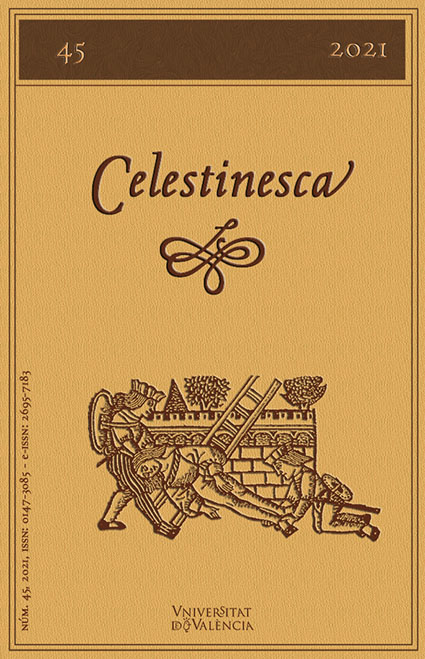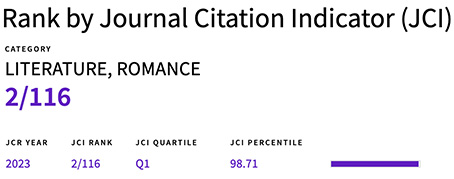Law New and Old: Tropes of Blindness in the Celestina
DOI:
https://doi.org/10.7203/Celestinesca.45.21022Keywords:
Celestina, law, allegory, Badius, Piccolomini, Nebrija, Cisneros Abstract
Abstract
This article traces juridical elements in the monologues of Melibea, Calisto and Pleberio in order to elaborate on the negotiations between old and new law and —on an allegorical level— old and re/new/ed faith as major topics of the tragicomedia. In a further step, I will connect this text-based analysis to the material culture of the early book in Spain, insofar as the production of printing shops in Salamanca and Burgos evidences a variety of texts with a similar preoccupation for legal reforms. This reveals the embeddedness of the Celestina in a network of European humanism. The re-occurrence of blind Justice as a key trope in such contemporaneous texts could shed new light on discussions about the authorship of the Celestina by reconciling different approaches.
 Downloads
Downloads
 References
References
Algaba Pacios, Nieves (2016), Enea Silvio Piccolomini en España. Con la edición del «Tratado de la miseria de los cortesanos». (Sevilla, Cromberger, 1520), Madrid, Universidad Complutense, tesis doctoral. https://eprints.ucm.es/id/eprint/40085
Baranda, Consolación (2003), «Cambio social en La Celestina y las ideas jurídico-políticas en la Universidad de Salamanca.», in El Mundo social y cultural de la «Celestina». Actas del congreso internacional, Universidad
de Navarra, junio, 2001, ed. Ignacio Arellano and Jesús M. Usunáriz, Madrid, Iberoamericana – Vervuert, pp. 9-25. https://doi.org/10.31819/9783964566102-002
Bataillon, Marcel (1961), «La Célestine» selon Fernando de Rojas, Paris, Marcel Didier.
— (1966), Erasmo y España. Estudios sobre la historia espiritual del siglo XVI, México – Madrid – Buenos Aires, Fondo de Cultura Económica.
Benke, Nikolaus (2012), «On the Roman Father's Right to Kill his Adulterous Daughter», The History of the Family, 17.3, pp. 284-308. https://doi.org/10.1080/1081602X.2012.695940
Canet Vallés, José Luis (2008), «La Celestina en la "contienda" intelectual y universitaria de principios del siglo XVI», Celestinesca, 32, pp. 85-108. https://doi.org/10.7203/Celestinesca.32.20109
— (2016), «Reflexiones sobre el libro ilustrado del impresor Fadrique Biel de Basilea», Revista de Poética Medieval, 30, pp. 81-104. https://doi.org/10.37536/RPM.2016.30.0.50219
— (2017), «The Early Editions and the Authorship of Celestina», in A Companion to «Celestina», ed. Enrique Fernandez, Leiden, Brill, pp. 21-41. https://doi.org/10.1163/9789004349322_003
Celestina comentada, ed. Luise Fothergill-Payne, Enrique Fernández Rivera and Peter Fothergill-Payne, Salamanca, Ediciones Universidad de Salamanca, 2002.
Duhl, Olga Anna (2007), «Vernacular Translation and the Sins of the Tongue: From Brant’s Stultifera Navis (1494) to Droyn's La Nef des folles (c. 1498)», Fifteenth Century Studies, 32, pp. 53-67.
Eisenstein, Elisabeth (1983), The Printing Revolution in Early Modern Europe, Cambridge, Cambridge University Press.
Esparza Torres, Miguel Angel, and Hans-Josef Niederehe (1999), Bibliografia Nebrisense. Las obras completes del humanista Antonio de Nebrija desde 1481 hasta nuestros días, Amsterdam, John Benjamins Publishing. https://doi.org/10.1075/sihols.90
Goodrich, Peter (2010), «Legal Enigmas – Antonio de Nebrija, The Da Vinci Code and the Emendation of Law», Oxford Journal of Legal Studies, 30.1, pp. 71–99. https://doi.org/10.1093/ojls/gqq001
Iglesias, Yolanda (2015), «Implicaciones legales de las seis muertes en La Celestina: Un acercamiento histórico-literario», Romance Quarterly, 62.2, pp. 59-70. https://doi.org/10.1080/08831157.2015.998595
Jusdado Ruiz-Capillas, Miguel Ángel (2008), «Ius Commune y Common Law», Cuadernos de Historia del Derecho, 15, pp. 327-344. https://revistas.ucm.es/index.php/CUHD/article/view/CUHD0808110327A
Kagan, Richard L. (1974), Students and Society in Early Modern Spain, Baltimore, Johns Hopkins University Press, 1974. https://doi.org/10.1353/book.67888
Lacarra Lanz, Eukene (2007), «La muerte irredenta de Melibea», in Proceedings of the International Symposium «1502-2002: Five Hundred Years of Fernando de Rojas' "Tragicomedia de Calisto y Melibea" (18-19 October
2002, Department of Spanish and Portuguese, Indiana University, Bloomington), ed. and intr. Juan Carlos Conde, New York, Hispanic Seminary of Medieval Studies, pp. 173-208.
Leaños, Jaime (2007), Piccolomini en Iberia influencias italianas en el génesis de la literatura sentimental española, Potomac, Md. Scripta Humanistica.
Matos, Kevin (2018), «De Lucrecia a Melibea: la concepción del erotismo femenino en la Historia de duobus amantibus de Piccolomini y en la Tragicomedia de Calisto y Melibea de Rojas», Celestinesca, 42, pp. 189-224. https://doi.org/10.7203/Celestinesca.42.20221
Möller, Ernst von (1905), «Die Augenbinde der Justitia», Zeitschrift für Christliche Kunst, XVIII.4, coll. 107–122, 141–152.
Panofsky, Erwin (1982), Studies in Iconology: Humanistic Themes in the Art of the Renaissance, Chicago, Chicago University Press.
Pérez Fernández, José María (2014), «Translation, Sermo Communis, and the Book Trade», in Translation and the Book Trade in Early Modern Europe, ed. José María Pérez Fernández, Cambridge, Cambridge University Press, pp. 40-60. https://doi.org/10.1017/CBO9781139942393.003
Perona, José (1991), «Latina uocabula ex iure ciuili in uoces hispanienses interpretata. II,1, de Elio Antonio de Nebrija», Cahiers d’études hispaniques médiévales, 16.1, pp. 189-365. https://doi.org/10.3406/cehm.1991.966
Piccolomini, Eneas Silvio (2001), «Estoria muy verdadera de dos amantes, Euríalo franco y Lucrecia senesa», ed. Ines Ravasani, in Tratados de amor en el entorno de «Celestina» (siglos XV-XVI), ed. Pedro Cátedra et al., Madrid, Sociedad Estatal España Nuevo Milenio, pp. 161-217.
Prosperi, Adriano (2018), Justice Blindfolded: The Historical Course of an Image, Leiden, Brill. https://doi.org/10.1163/9789004368675_001
Ravasini, Ines (2003), Estoria muy verdadera de dos amantes. Traduzione castigliana anonima del XV secolo, Roma, Bagatto Libri.
Rojas, Fernando de, y antiguo autor (2011), La Celestina. Tragicomedia de Calisto y Melibea, ed. Francisco J. Lobera et al., Madrid, Real Academia Española.
Rowe, Nina (2011), The Jew, the Cathedral and the Medieval City: Synagoga and Ecclesia in the Thirteenth Century, Cambridge, Cambridge University Press.
Schlickers, Sabine (2014), «Cherchez la femme: Genealogie und Entwicklung der spanischen novela picaresca», LiLi, Zeitschrift für Literaturwissenschaft und Linguistik, 175 (44), pp. 49-64. https://doi.org/10.1007/BF03379984
Serés, Guillermo (2011), «La obra y los autores del la Comedia a la Tragicomedia», in La Celestina. Tragicomedia de Calisto y Melibea, ed. Francisco J. Lobera et al., Madrid, Real Academia Española, pp. 361-401.
Snow, Joseph T. (2004), «Celestina Examined: A View from the Sixteenth Century», La Corónica, 33.1, pp. 181-196. https://doi.org/10.1353/cor.2004.0037
Sullivan, Henry W. (1976), «Moral Probabilism and Casuistry in Spain during the Counter Reformation», in Tirso de Molina and The Drama of the Counter Reformation, Amsterdam, Rodopi, pp. 40-51.
Weis, Adolf (1947), «Die Synagoge am Münster zu Strassburg», Das Münster, I, pp. 65-80.
White, Paul (2014), «Marketing Adaptations of the Ship of Fools: The Stultiferae naves (1501) and Navis stultifera (1505) of Jodocus Badius Ascensius», in Translation and the Book Trade in Early Modern Europe, ed. José María Pérez Fernández and Edward Wilson-Lee, Cambridge, Cambridge University Press. https://doi.org/10.1017/CBO9781139942393.002
Wolkan, Rudolf, ed. (1912), «Der Briefwechsel des Eneas Silvius Piccolomini: Abt. 2. Briefe als Priester und als Bischof von Triest», Fontes Rerum Austriacarum, 67, pp. 33–39.
Downloads
Published
How to Cite
-
Abstract612
-
PDF243
Issue
Section
License
![]() Celestinesca is committed to the dissemination of knowledge, that is why access to its contents is free and is ruled by a Creative Commons Attribution-NonCommercial-NoDerivatives 4.0 license.
Celestinesca is committed to the dissemination of knowledge, that is why access to its contents is free and is ruled by a Creative Commons Attribution-NonCommercial-NoDerivatives 4.0 license.
Authors retain the rights to their works. Therefore, they can disseminate them and deposit them in the repository, institutional or not, that they wish. However, they are kindly requested to do so by providing the full bibliographic reference and the corresponding DOI.
Celestinesca does not charge authors for submitting, processing, reviewing or publishing their articles.





